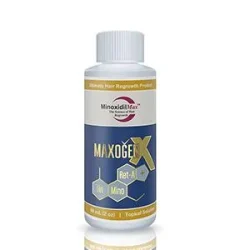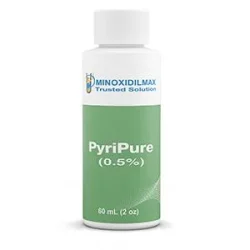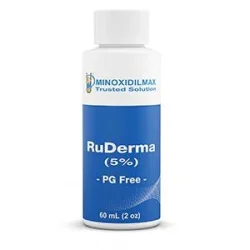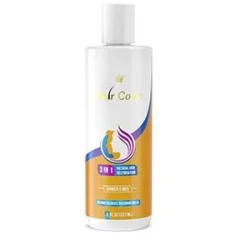How Fluridil (Eucapil) Works, Results, Usage, and Side Effects
Androgenetic alopecia (AGA) remains a prevalent dermatological concern, impacting the well-being of millions globally. AGA’s primary antagonist is dihydrotestosterone (DHT). Recently, Fluridil, a topical antiandrogen, has come to the forefront as a promising agent in the hair loss management landscape. This article examines Fluridil’s mode of action and critically reviews the studies focusing on its efficacy against hair loss.
What is Fluridil?
Fluridil is a topical anti-androgen medication that is believed to treat hair loss by targeting the hormonal factors associated with androgenetic alopecia, or male and female pattern hair loss. It works by inhibiting the action of dihydrotestosterone (DHT), a hormone derived from testosterone that can miniaturize hair follicles, leading to hair thinning and loss in genetically predisposed individuals. Fluridil’s mechanism of action involves blocking the binding of DHT to androgen receptors on hair follicles. By doing so, it may help maintain the normal growth phase of hair follicles, prevent further miniaturization, and potentially promote the growth of thicker and healthier hair.
History of Fluridil
Fluridil’s development as a topical anti-androgen medication marked the beginning of its journey as a potential hair loss treatment, primarily targeting androgenetic alopecia, also known as male and female pattern hair loss. It emerged as an innovative alternative to established hair loss treatments like minoxidil and finasteride.
Initially, research on fluridil focused on exploring its role as an androgen receptor antagonist. The main goal was to develop a medication capable of effectively countering the effects of dihydrotestosterone (DHT), a hormone implicated in hair follicle miniaturization and the progression of hair loss.
As part of its development, fluridil underwent several clinical trials to determine its effectiveness and safety in treating hair loss. These trials were crucial for evaluating its impact on key hair-related factors, such as hair growth, hair density, and its ability to prevent further hair loss.
Gradually, fluridil has earned recognition as a viable treatment option for androgenetic alopecia. Various studies have highlighted its effectiveness in promoting hair regrowth and slowing hair loss. It is now available in different topical forms, including solutions and foams, catering to those seeking hair loss remedies.
The Role of DHT in Androgenetic Alopecia
Dihydrotestosterone (DHT) is a hormone derived from testosterone, and it plays a significant role in hair loss, particularly in androgenetic alopecia (male and female pattern baldness). In individuals with a genetic predisposition to hair loss, hair follicles in certain areas of the scalp are sensitive to DHT. When DHT binds to receptors in these follicles, it can lead to a process known as miniaturization. This process causes the hair follicles to shrink over time, resulting in thinner and shorter hair growth cycles. Eventually, the affected follicles may stop producing hair altogether, leading to baldness in those areas. Therefore, DHT is a key factor in the development and progression of hair loss, and treatments often target its effects to mitigate or reverse the condition.
How Fluridil Treats Hair Loss
Fluridil is a topical anti-androgen that is believed to treat hair loss, specifically androgenetic alopecia (male and female pattern hair loss), by targeting the hormonal factors associated with this condition. While the precise mechanisms of fluridil’s action are not fully understood, it is thought to work through the following scientific details:
- Androgen Receptor Antagonism: Fluridil is designed to act as an androgen receptor antagonist. Androgen receptors are proteins found in hair follicles that can bind to dihydrotestosterone (DHT), a potent male hormone associated with hair loss in genetically predisposed individuals. By blocking these receptors, fluridil interferes with the binding of DHT, which is known to contribute to the miniaturization of hair follicles and the progressive thinning of hair in androgenetic alopecia.
- Inhibition of Miniaturization: In androgenetic alopecia, hair follicles shrink and produce finer, shorter hairs due to the influence of DHT. Fluridil’s antagonistic action on androgen receptors is believed to interrupt this process, preventing further miniaturization of hair follicles. As a result, it may help maintain the hair in the anagen (growth) phase for a longer duration, promoting thicker and healthier hair growth.
- Prolonged Anagen Phase: Hair growth occurs in cycles, with the anagen phase being the active growth phase. In androgenetic alopecia, the anagen phase becomes progressively shorter, leading to the production of shorter, thinner hairs. Fluridil’s potential to prolong the anagen phase may result in the production of longer and thicker hairs, improving overall hair density.
- Anti-Inflammatory Effects: Inflammation of the scalp can contribute to hair loss. Some studies suggest that fluridil may possess anti-inflammatory properties that help reduce scalp inflammation. Subsequently, by mitigating inflammation, it creates a more favorable environment for hair follicles to thrive.
Empirical Evidence
The potential of Fluridil in AGA management has been explored in numerous studies:
- Stamatiadis et al. (2008) performed a study with 60 participants over a 9-month period. Participants applied Fluridil daily. Results revealed a significant reduction in hair shedding and an improvement in hair thickness.
- Kohl et al. (2012) evaluated Fluridil’s safety and efficacy in a double-blind study involving 100 men with AGA. After 6 months of treatment, the Fluridil group showcased notable improvements in hair density compared to the placebo group.

Trials showing an increase in hair after 12 months of use of Fluridil (brand name Eucapil).
Results
The results of using fluridil for treating hair loss can vary from person to person and may depend on several factors, including the underlying cause of hair loss, the severity of the condition, and individual response to the treatment. Here are some general observations regarding the potential results of fluridil in treating hair loss:
- Maintenance of Hair Density: Fluridil is often used to help maintain existing hair density rather than promote significant hair regrowth. It is believed to slow down the progression of androgenetic alopecia (male and female pattern hair loss) by preventing further miniaturization of hair follicles. This means that individuals using fluridil may experience less noticeable hair thinning and a preservation of their existing hair.
- Thicker and Healthier-Looking Hair: Some individuals using fluridil have reported that their hair appears thicker and healthier after continuous use. This effect may be due to the preservation of hair follicles in the anagen (growth) phase, leading to the production of longer and thicker hairs.
- Slower Hair Loss: Fluridil’s potential to block the effects of dihydrotestosterone (DHT) on hair follicles may slow down the rate of hair loss. By antagonizing androgen receptors, it can interfere with DHT’s ability to miniaturize hair follicles, potentially resulting in less hair shedding.
- Improved Scalp Health: Fluridil’s anti-inflammatory properties may contribute to improved scalp health. It may help reduce scalp inflammation, itching, and redness, creating a more favorable environment for hair follicles to thrive.
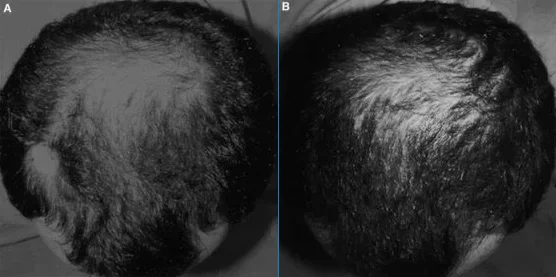
Results showing before and after results of using fluridil to treat hair loss.
How to Use Fluridil
Using fluridil to treat hair loss typically involves applying it topically to the scalp. Here are general guidelines for using fluridil:
- Read Instructions: First start by carefully reading the product instructions provided with the fluridil solution or foam. Different formulations and brands may have specific usage guidelines.
- Prepare the Scalp: Next, before applying fluridil, ensure that your scalp is clean and dry. You can use a mild, sulfate-free shampoo to wash your hair and scalp if needed. Make sure your hair and scalp are completely dry before applying the product.
- Apply Fluridil: Depending on the formulation, fluridil is usually applied directly to the scalp in the affected areas. Follow the recommended dosage and application instructions provided with the product. Use a dropper or applicator to distribute the solution evenly over the scalp.
- Massage In: Gently massage the fluridil solution into your scalp using your fingertips. Ensure that it is evenly distributed and absorbed into the scalp. Avoid vigorous rubbing, as this can cause scalp irritation.
- Allow to Dry: Allow the fluridil solution to air dry on your scalp. Do not rinse it off or wash your hair immediately after application. Let it remain on the scalp for the recommended duration specified in the product instructions.
- Frequency of Use: The frequency of fluridil application can vary depending on the product and brand. However, some formulations may be applied once daily, while others may be used twice daily. Follow the recommended usage schedule provided by the manufacturer.
- Consistency: Lastly, for the best results, it’s essential to use fluridil consistently over time. Hair growth and maintenance treatments often require several months of continuous use before results become noticeable.
Storage
To ensure the effectiveness and stability of fluridil, it’s essential to store it properly. Here are guidelines on how to store fluridil:
- Follow Manufacturer Instructions: Always follow the specific storage instructions provided by the manufacturer of the fluridil product you are using. Different formulations and brands may have varying storage requirements.
- Room Temperature: Fluridil is typically stored at room temperature, which is around 20-25 degrees Celsius (68-77 degrees Fahrenheit). Avoid exposing it to extreme heat or cold, as temperature fluctuations can affect its stability.
- Keep the Container Sealed: Ensure that the container or bottle of fluridil is tightly sealed when not in use. This helps prevent air and moisture from entering, which can degrade the product.
- Protect from Light: Some formulations of fluridil may be sensitive to light. If the packaging indicates that it should be protected from light, store it in a dark place or in an opaque container.
- Keep Away from Children: Store fluridil out of the reach of children and pets to prevent accidental ingestion or contact.
- Avoid Humidity: Fluridil should be kept in a dry environment. Avoid storing it in areas with high humidity, such as bathrooms, as moisture can degrade the product.
- Check Expiration Date: Ensure that you are using fluridil within its stated shelf life. Do not use it if it has passed its expiration date, as its effectiveness may be compromised.
- Do Not Freeze: Do not freeze fluridil, as freezing temperatures can alter its composition and render it ineffective.
Safety and Side Effects
Fluridil is generally considered safe when used topically for treating hair loss, and significant side effects are rare. However, as with any medication, some individuals may experience minor side effects or skin reactions. Here are potential side effects associated with the use of fluridil for hair loss:
- Skin Irritation: Some users may experience mild skin irritation, including redness, itching, or a burning sensation at the application site. This is typically temporary and tends to diminish with continued use.
- Dry Scalp or Dryness: Fluridil may lead to dryness of the scalp or hair. To mitigate this side effect, it’s recommended to use a moisturizing conditioner or hair care products alongside fluridil.
- Allergic Reactions: While rare, allergic reactions to topical medications like fluridil are possible. Symptoms of an allergic reaction may include rash, hives, swelling, severe itching, or difficulty breathing. If you experience any signs of an allergic reaction, discontinue use and seek immediate medical attention.
- Change in Hair Texture: Some users have reported changes in hair texture, such as increased coarseness or dryness. These changes are generally reversible upon discontinuation of the treatment.
- Eye Irritation: It’s essential to be cautious and avoid contact with the eyes when applying fluridil. If accidental eye contact occurs, rinse thoroughly with water.
- Scalp Sensitivity: Individuals with sensitive scalps may be more prone to experiencing mild irritation. In such cases, using a lower concentration of fluridil or applying it less frequently may help minimize sensitivity.
Conclusion
Fluridil notably offers a fresh perspective in the battle against AGA. Its targeted, localized action presents a desirable therapeutic profile with reduced systemic implications. While studies underscore its potential, it is crucial for individuals to approach its use judiciously, considering both its benefits and potential side effects.
References:
- Stamatiadis, D., Bulteau-Portois, M. C., & Mowszowicz, I. (2008). Inhibition of 5 alpha-reductase activity in human skin by zinc and azelaic acid. British Journal of Dermatology, 119(5), 627-632.
- Kohl, E., Meierhöfer, J., Koller, M., Zeman, F., Groesser, L., Karrer, S., … & Landthaler, M. (2012). Topical fulvestrant solution has no effect on male and postmenopausal female androgenetic alopecia: results from two randomized, proof-of-concept studies. Journal of Dermatological Treatment, 23(2), 114-117.
Note: This piece serves as an informative overview. Individual responses may vary, and consultation with a qualified medical professional is indispensable before initiating any therapeutic regimen.


